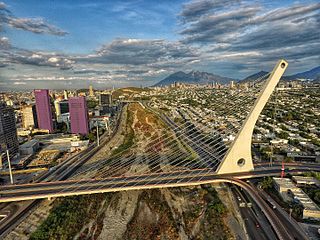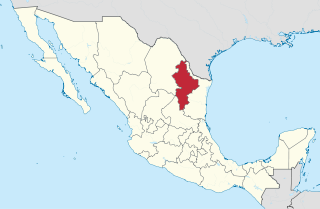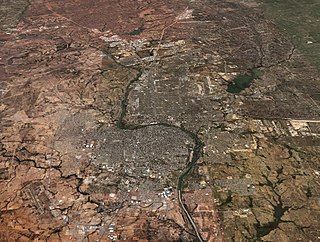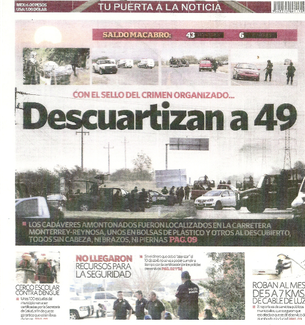
Monterrey is the capital and largest city of the northeastern state of Nuevo León, Mexico, and the ninth-largest city and second largest metro area in Mexico behind Greater Mexico City. Located at the foothills of the Sierra Madre Oriental, Monterrey is a major North American business and industrial hub, as well as the most populous city in Northern Mexico.

Nuevo León, officially the Free and Sovereign State of Nuevo León, is a state in northeastern Mexico. The state borders the Mexican states of Tamaulipas, Coahuila, Zacatecas, and San Luis Potosi, and has an extremely narrow international border with the U.S. state of Texas. Covering 64,156 square kilometers and with a population of 5.78 million people, Nuevo León is the thirteenth-largest federal entity by area and the seventh-most populous as of 2020.

Tamaulipas, officially the Free and Sovereign State of Tamaulipas, is a state in Mexico; one of the 31 states which, along with Mexico City, comprise the 32 Federal Entities of Mexico. It is divided into 43 municipalities.

Linares is a small city in the state of Nuevo León, Mexico. The city serves as the administrative centre for the surrounding municipality of the same name and it is the largest urban centre of the so-called "orange belt" region. The city had a 2005 census population of 56,065, while the municipality's population was 71,061. The city and the municipality both rank tenth in population in the state. The municipality has an area of 2,445.2 km² and lies in the east-southeast part of the state on the border with the state of Tamaulipas. The municipality of Hualahuises is an enclave of Linares municipality.
Rayones is a municipality in the Mexican state of Nuevo León. It is named after the Rayón brothers, who were insurgent heroes of the country's independence achieved in 1821. The town was founded in 1852.
Federal Highway 85 connects Mexico City with the Mexico–United States border at Nuevo Laredo, Tamaulipas. Highway 85 runs through Monterrey, Nuevo León; Ciudad Victoria, Tamaulipas; Ciudad Valles, San Luis Potosí; and Pachuca, Hidalgo. It ends at the intersection of Highway 95 in the San Pedro area of Mexico City. Highway 85 is the original route of the Pan-American Highway from the border to the capital as well as the Inter-American Highway.
Federal Highway 40, also called the Carretera Interoceánica, is a road beginning at Reynosa, Tamaulipas, just west of the Port of Brownsville, Texas, and ending at Fed. 15 in Villa Unión, Sinaloa, near Mazatlán and the Pacific coast. It is called Interoceanic as, once finished, the cities of Matamoros, Tamaulipas, on the Gulf of Mexico and Mazatlán on the Pacific Ocean will be linked.
Cadereyta Jiménez is the name of a city as well as of a municipality in the Mexican state of Nuevo León.

The Laredo–Colombia Solidarity International Bridge is one of four vehicular international bridges located on the U.S.–Mexico border in the city of Laredo, Texas; it connects Laredo over the Rio Grande with Colombia, Nuevo León. It is owned and operated by the City of Laredo and the Secretaría de Comunicaciones y Transportes.
Tamaulipas State Highway 1 is a highway that runs from Nuevo Laredo, Tamaulipas Mexico west to Nuevo Leon State Highway 1 on the Nuevo Leon / Tamaulipas borderline. This highway with its Nuevo Leon side connects Nuevo Laredo with Anáhuac, Nuevo Leon.

Laredo–Nuevo Laredo, otherwise known as the "Four-State Area" or the "Quad State Area", is one of six transborder agglomerations along the U.S.-Mexican border. The city of Laredo is situated in the U.S. state of Texas on the northern bank of the Rio Grande and Nuevo Laredo is located in the Mexican State of Tamaulipas in the southern bank of the river. This area is also known as the Two Laredos or the Laredo Borderplex. The area is made up of one county in the U.S and three municipalities in Mexico. Two urban areas, three cities, and 12 towns make the Laredo–Nuevo Laredo Metropolitan area. The two sides of the Borderplex are connected by four International Bridges and an International Railway Bridge. The Laredo–Nuevo Laredo Metropolitan area has a total of 636,516 inhabitants according to the INEGI Census of 2010 and the United States Census estimate of 2010. According to World Gazetteer this urban agglomeration ranked 157th largest in North and South America in 2010 with an estimated population of 675,481. This area ranks 66th in the United States and 23rd in Mexico.
Federal Highway 35 is a free part of the federal highways corridors of Mexico, that is in two separate improved segments.

Carretera Federal 85D is the designation for toll highways (autopistas) paralleling Federal Highway 85. Two roads are designated Highway 85D, one from Nuevo Laredo, Tamaulipas, to Monterrey, Nuevo León, known as Autopista Monterrey–Nuevo Laredo, and the other from Pachuca, Hidalgo, to Mexico City, known as Autopista Pachuca–Ciudad de México. Both toll routes run parallel to their free alternative, Federal Highway 85. Highway 85D has wider lanes offers a more direct route and is continuously being repaired and repaved unlike the free route.
Federal Highway 9 is a toll-free part of the federal highway corridors. It crosses the center of Nuevo León, from Allende, Nuevo León to Cadereyta, Nuevo León. It has a length of 38 km (24 mi).
Federal Highway 58 (Fed. 58) is a free (libre) part of the federal highways corridors of Mexico. The highway travels from San Roberto Junction, Nuevo León in the west to Linares, Nuevo León in the east.

The Cadereyta Jiménez massacre occurred on the Fed 40 on 12–13 May 2012. Mexican officials stated that 49 people were decapitated and mutilated by members of Los Zetas drug cartel and dumped by a roadside near the city of Cadereyta Jiménez in northern Mexico. The Blog del Narco, a blog that documents events and people of the Mexican Drug War anonymously, reported that the actual (unofficial) death toll may be more than 68 people. The bodies were found in the town of San Juan in the municipality of Cadereyta Jiménez, Nuevo León at about 4 a.m. on a non-toll highway leading to Reynosa, Tamaulipas. The forty-three men and six women killed had their heads, feet, and hands cut off, making their identification difficult. Those killed also bore signs of torture and were stuffed in plastic bags. The arrested suspects have indicated that the victims were Gulf Cartel members, but the Mexican authorities have not ruled out the possibility that they were U.S.-bound migrants. Four days before this incident, 18 people were found decapitated and dismembered near Mexico's second largest city, Guadalajara.

Allende Municipality is a municipality located in the northeastern Mexican state of Nuevo León. It comprises a region known as Región Citrícola, for being a major producer of orange at local, national and even international level. Allende is located at the Sierra Madre Oriental range foothills in the central-southeastern part in the state of Nuevo León. It has a territorial extension of 148.5 km2, comprising around 0.22% of the whole extension of Nuevo León. Given its geographic location, the region consists of valleys and hills ranging from 300 meters above sea level on the northeast, to 1,640 meters above sea level in the southwestern part of the municipality. According to the 2010 census data, it had a population of 32,581, of whom 16,436 were men and 16,145 were women. The main economic activities are agriculture, livestock, beekeeping, poultry and transportation, activities that generate many jobs in the region.
Mexican Highways are composed of two groups:
Federal Highway 40D is the designation for toll highways paralleling Mexican Federal Highway 40. Highway 40D connects Mazatlán, Sinaloa to Reynosa, Tamaulipas. It forms most of the highway corridor between Mazatlán and Matamoros, Tamaulipas, one of 14 major highway corridors in the country.

Samuel Alejandro García Sepúlveda is a Mexican lawyer and politician serving as the Governor of Nuevo León. A member of the Citizens' Movement party, he served as a local deputy in the Congress of Nuevo León from 2015 to 2018 and represented Nuevo León in the Senate from 2018 to 2020.









